Welcome to Matrix Education
To ensure we are showing you the most relevant content, please select your location below.
Select a year to see courses
Learn online or on-campus during the term or school holidays
Learn online or on-campus during the term or school holidays
Learn online or on-campus during the term or school holidays
Learn online or on-campus during the term or school holidays
Learn online or on-campus during the term or school holidays
Learn online or on-campus during the term or school holidays
Learn online or on-campus during the term or school holidays
Get HSC Trial exam ready in just a week
Get HSC exam ready in just a week
Select a year to see available courses
Science guides to help you get ahead
Science guides to help you get ahead
Shot angles are an essential element to examine when analysing films. So, let's see what angles can mean!
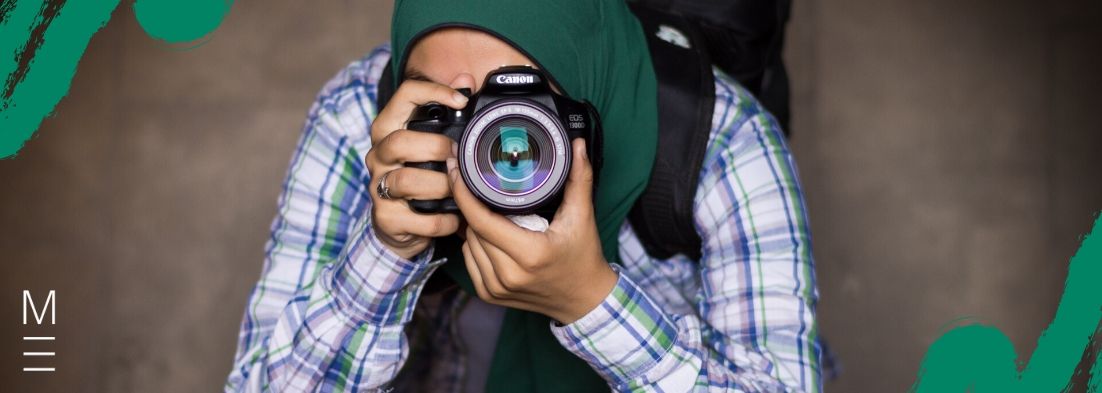
Guide Chapters
Join 75,893 students who already have a head start.
"*" indicates required fields
You might also like

Join 8000+ students each term who already have a head start on their school academic journey.
Unsure of how to analyse shot angles in film? Don’t worry. We got your back! We will go through different types of angles, their general effect, show you how to analyse shot angles, and guide you through an example of how to analyse them.
Create powerful study notes and start writing more insightful essays on film Fill out your details below to get this resource emailed to you. "*" indicates required fields
Download your FREE Film Analysis Planner

Download your FREE Film Analysis Planner
The angle of a shot, in film, refers to the height that the camera is positioned in relation to the subject.
It is important that you don’t get this confused with shot types. Shots, as they are commonly referenced, refer to the distance of the camera, whereas, shot angles, or, alternatively, film angles, angles, or camera angles (phew! That’s a lot of synonymous terms), refer to the height and tilt of the camera.
There are a variety of different shot angles that directors can use.
Different angles are used for developing meaning: to provide different perspectives and to shape the audience’s emotions and responses.
Different angles produce different effects for the audience. It is important that you remember all the different angles that directors use in films and know their general effects.
So, let’s take a look now!
| Angle of shot | Definition | Effect | Example |
| High angle shot | Filmed from above, where the camera is tilted down onto a subject (approximately 45 degrees) | This makes the subject seem smaller and inferior. |  |
| Bird’s eye view shot | Filmed from directly overhead a subject (90 degrees). It is usually is positioned far away so that the subject looks small. | It is usually used to quickly set or capture the scene, capture action, or make a subject seem inferior and small. | 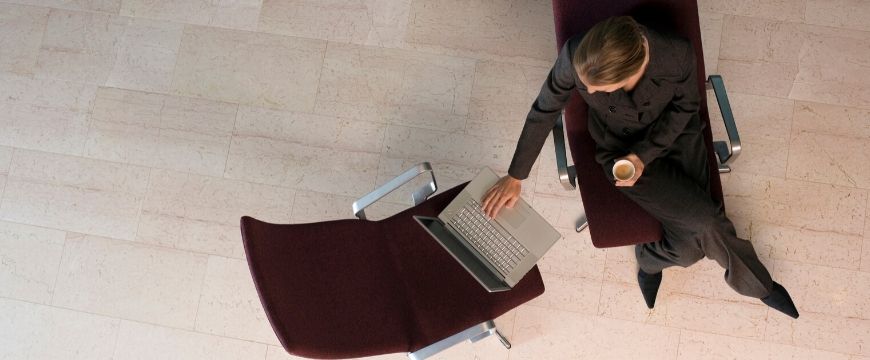 |
| Low angle shot | Film from below, where the camera is tilted up towards a subject (approximately 45 degrees). | This makes the subject seem bigger and superior. |  |
| Worm’s eye view shot | Filmed from directly below a subject (90 degrees). The camera is usually placed at ground level. | Worm’s eye view angle makes the subject seem extremely tall and superior. It also creates a disorienting effect. | 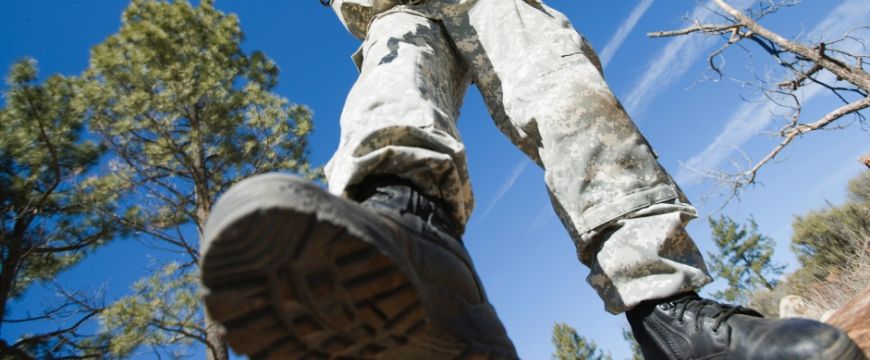 |
| Eye-level angle (straight-on) shot | Filmed eye-level to the subject. | This is the most common angle you will see. It is a neutral shot that is used to convey information. |  |
| Dutch/Tilted/Canted angle shot | The camera is tilted on a horizontal axis. | Dutch angles create a disorienting effect. Directors tend to use this angle to represent insanity and madness. | 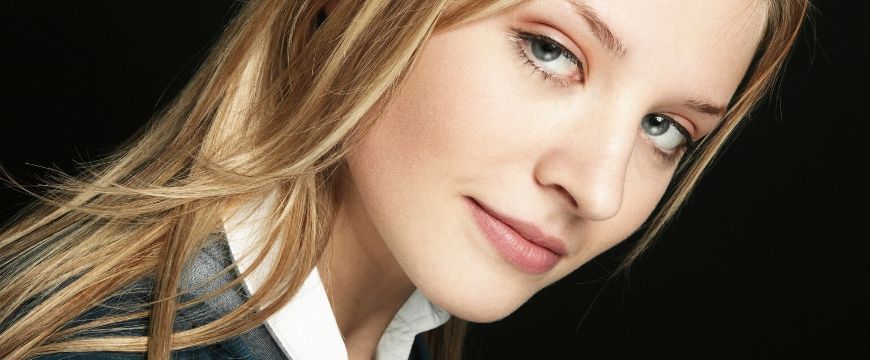 |
Now that we know the different effects of different angles used in films, let’s see how we can analyse them!
Firstly, you need to identify the angle used in the scene.
Take a few screen grabs of the scene to make this easier for you to do.
You should remember all the different types of shot angles and be comfortable with identifying them. If you’re not, take another read of the above table and continue to practise identifying different angles when you’re watching films!
Here’s a handy image to help you remember the shot types.
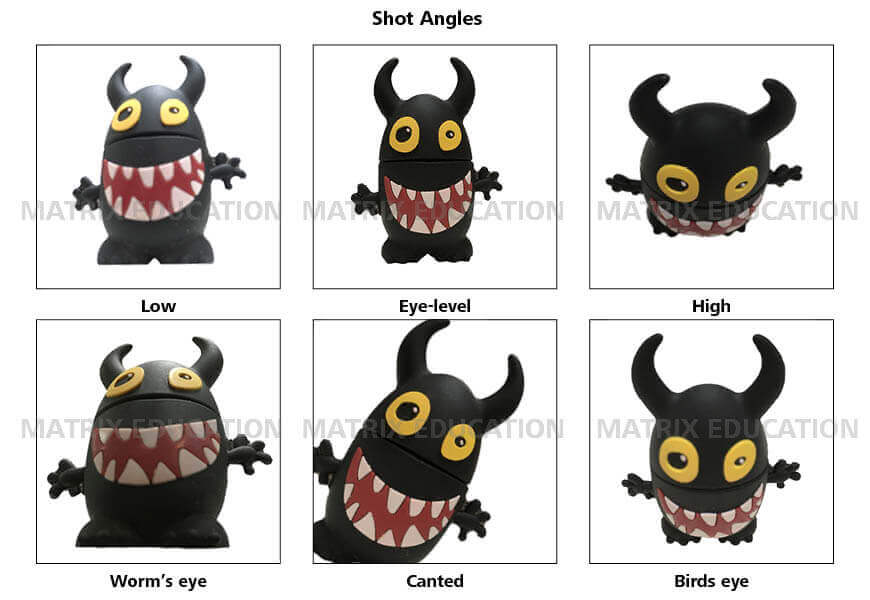
Each angle type produces similar effects every time. However, this doesn’t mean that it produces the exact same effect every single time.
So, this step is about identifying the general effect of the angle and adapting it to the atmosphere of the scene.
Let’s see how we can do this:
a. Identify the atmosphere of the scene
Pay attention to your emotions when you watch the scene. Are you frightened, happy, sad, or tense? This will help you identify the mood and atmosphere of the scene.
b. Recall the table above
Now, you need to recall the general effects of the angle from the table above. Try to memorise the angles and their effects by heart. This will help you analyse angles faster.
c. Adapt your findings to the atmosphere of the scene
After you’ve identifies the atmosphere and the general effect of the angle, you need to combine these findings.
Relate your general effect back to the atmosphere of the scene. Think about how the angle helps the director convey a particular mood.
Now, we need to further ground our findings to the context of the film. Doing this will add sophistication and depth to your analysis.
This step is all about finding the meaning behind the technique and identifying it’s significance.
So, let’s see how we can do this:
a. Identify the film’s themes
Try to figure out the film’s main message and identify ideas and issues that the film consistently discuss. These are your themes.
b. Figure out what is happening in the film
You need to know the storyline of the film and exactly what is happening in your scene to properly analyse the film. Ensure that you know where your scene is placed in regards to the whole film.
c. Adapt the general effect to the above findings
Now, it’s time to find the significance of the effect. To do this, you need to combine all your findings (general effect, themes, and what is happening in the film).
Try to figure out how the effect of the film helps the director emphasise the themes and meaning of the film.
Now, we have all the necessary ingredients to put together a T.E.E.L paragraph.
T.E.E.L stands for:
You can find a more detailed explanation of using T.E.E.L in our post on paragraph structure (this post is part of our series on Essay Writing and shows you the methods Matrix English Students learn to write Band 6 essays in the Matrix Holiday and Term courses).
Now that we know how to analyse angles, let’s put it in practice. We will be analysing a scene from Danny DeVito’s Matilda.
In summary, Maltida is about a gifted girl with telekinesis powers who play tricks on the big bully principal, Miss Trunchbull.
Firstly, take a screengrab of some key moments of the scene. Here are a few that we’ve taken:
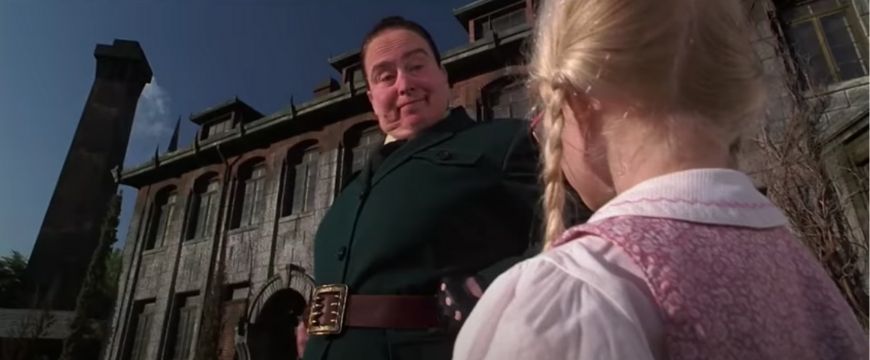
At a glance, we can immediately identify a low angle shot being used in this scene. The camera is situated at a lower position than Miss Trunchbull and is tilted upwards.
a. Identify the atmosphere of the scene
This scene is tense, and frightening but also, quite humorous.
Miss Trunchbull seems scary and intimidating as she threatens Amanda and grabs her pigtails to swing her across the field. However, the process of her swinging Amanda is quite humorous.
b. Recall the table above
From the table, we can recall that low angles are used to show superiority and dominance.
c. Adapt your findings to the atmosphere of the scene
Since the atmosphere of the scene is quite tense, we can determine that the effect of low angle shots is to make Miss Trunchbull seem more dominant.
Now, it’s time to further ground the general effect to make it specific to this scene.
a. Identify the film’s themes
The main themes in Matilda are reward vs punishment, greed, education, love, and power.
b. Figure out what is happening in the film
In this scene, we learn about Trunchbull’s cruel punishments towards the students as Matilda and her friends talk. We also see Miss Trunchbull pick on Amanda because of her pigtails. After insulting Amanda, Miss Trunchbull picks Amanda up by her pigtails and tosses her across the field.
c. Adapt the general effect to the above findings
We can see that low angle shot is used to convey Miss Trunchbull’s power and dominance over the children. This angle, alongside with her facial expression, emphasises her hatred for children and how she creates fear in the children to maintain her power.
| Danny Devito highlights how one’s greed for power can cause humans to resort to cruel and unfair punishments to maintain this position. We see this with the low angle shot of Miss Trunchbull’s angry face in Matilda, where she threatens a young student, Amanda, and swings her across the school by her pigtails. Here, the low angle shot makes Miss Trunchbull seem much taller, as though she is towering over little Amanda. It asserts Miss Trunchbull’s power and dominance over the students and emphasises her unfair hatred towards these children through the exaggerated angry facial features. As such, Devito emphasises how an individual’s desire for power can compel them to act cruelly to maintain it. |
Get ahead of your peers and ace your film analysis now. Learn how to analyse angles and other film techniques, and how to write about them with our expert teachers. Learn more about our Year 11 English Course now.
Produce insightful analysis & Band 6 essays!
Expert teachers. Band 6 resources. Proven results. Boost your English marks with our On Campus course.
Written by Matrix English Team
The Matrix English Team are tutors and teachers with a passion for English and a dedication to seeing Matrix Students achieving their academic goals.© Matrix Education and www.matrix.edu.au, 2025. Unauthorised use and/or duplication of this material without express and written permission from this site’s author and/or owner is strictly prohibited. Excerpts and links may be used, provided that full and clear credit is given to Matrix Education and www.matrix.edu.au with appropriate and specific direction to the original content.